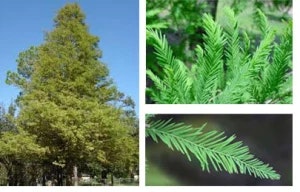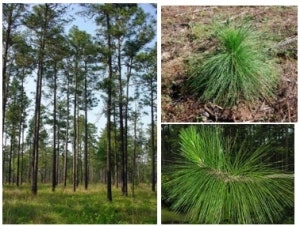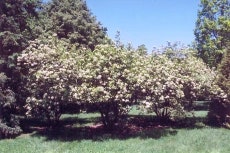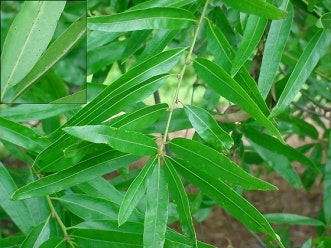Shade/Other trees and shrubs

Bald Cypress
A large, long-lived tree, the Bald Cypress has a pyramidal crown, and typically has a swollen, fluted lower trunk. The light green feathery foliage turns orange-brown in the fall. These trees are naturally found in moist to swampy conditions, generally in/ near moving water, but this tree does very well on drier sites. It can grow up to 125′. For more information see: USDA Plant Guide Cypress.
Longleaf Pine
Many early non-Indian settlers in the Southeastern United States considered longleaf pine the most valuable of all the kinds of pines. Its needles, bark and turpentine have been used for many different medicinal purposes. It grows to around 120 feet tall with a fully mature truck at 30 inches in diameter. It is incredible resistant to fire and hurricanes and grows well in most environments, but is very susceptible to competing vegetation. For more information see: USDA Plant Guide Longleaf pine.

Red Maple
The Red Maple tree has a narrow and rounded form. It has a fast growth rate and can reach more than 75′ in height. It favors a soil with an adequate water supply, and it can grow the sun or with broken shade. For more information see: USDA Plant Guide Red Maple.

River Birch
The River Birch is a narrow tree. It has a fast growth rate and can reach 60′ or more in height. Favors a moist soil. It can grow in full sun or partial shade. It makes a nice specimen tree. For more information see: USDA Plant Guide River Birch.

Southern Red Cedar
The Red Cedar tree is an evergreen tree. It has a slow to medium growth rate and can reach up to 60′ in height. There are no specific soil requirements. It can grow in full sun or partial shade. It is used as a specimen tree or for screening. Birds love its fruits. For more information see: USDA Plant Guide Red Cedar.

Sycamore
The American Sycamore is one of the largest and most well known trees in eastern North America, often reaching more than 100′. It is noted for mottled brown, green, gray and white exfoliating bark and the distinctive ball-like fruit clusters. Adaptable. For more information see: USDA Plant Guide Sycamore.

Wax Myrtle
The Wax Myrtle is a dense attractive evergreen tree. It is a fast grower to 15′ – 20′ in height. It is typically found in moist areas, but is adaptable to other soils. Does well in full sun or partial shade. It is a good wildlife plant, and screen. For more information click HERE.

Winged Elm
The winged elm (Ulmus alata), a deciduous tree, native to the southern woodlands of the United States, grows in both wet areas and dry, making it a very adaptable tree for cultivation. Also known as the corked elm; the tree is often used as a shade tree or street tree. The winged elm gets its name from the very broad, warty growths, thin and wing-like, that grow along its branches. They provide a fall display by turning a bright yellow at summer’s end. Flowers are brown or burgundy and appear before the leaves in March or April, and produce the fruit, a very short orange samara that disperses by the end of April.


Rusty Black Haw
A large Southern shrub or small tree. Height 6′ to 18′. The small blackish fruits appear in Sept-Oct and are eaten by foxes, quail and songbirds. This tree is common along the fence rows of the South, as the seeds are deposited there by the birds who eat the fruit. The fruits can also be eaten by humans, but rarely are.



Willow oak
Willow oak is a medium to large sized deciduous tree with lance shaped leaves that are quite willowlike. Willow oaks can get as tall as 130 ft, but are more commonly 40-60 ft tall. This oak occurs along streams, in bottomlands and in wet woods.


Sweetgum
Star-shaped leaves change through a beautiful rainbow of colors in the fall. Its fruit is a peculiar spiny ball, golfball-sized, that persists through winter on the tree. The sweetgum is one of the most pH-tolerant of all trees, thriving equally well in acid or alkaline conditions.



Green ash
Green ash leaves are olive-green to yellowish green on top and pale green underneath. They turn clear yellow in fall. The fruit is an elongated single-seeded samara with a single wing, reminiscent of one-half of a maple samara. Green ash is a popular landscaping and shelterwood tree and several cultivars have been named.
